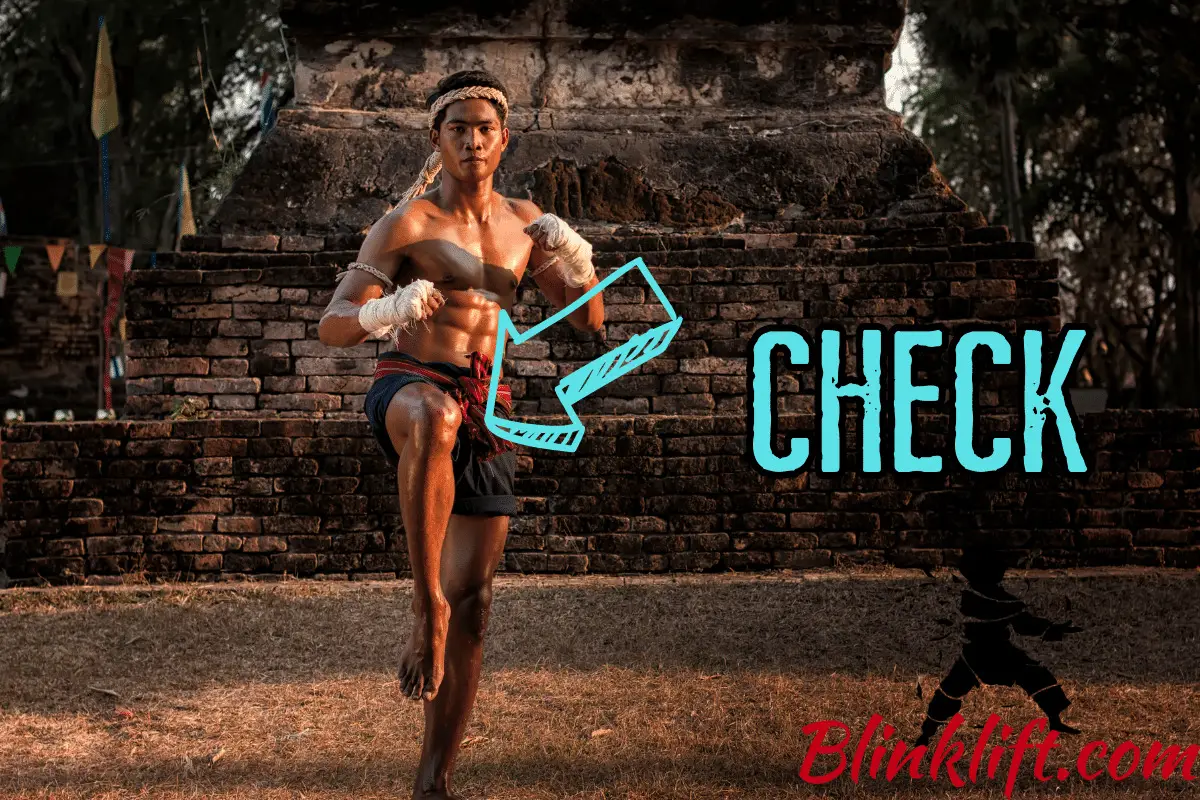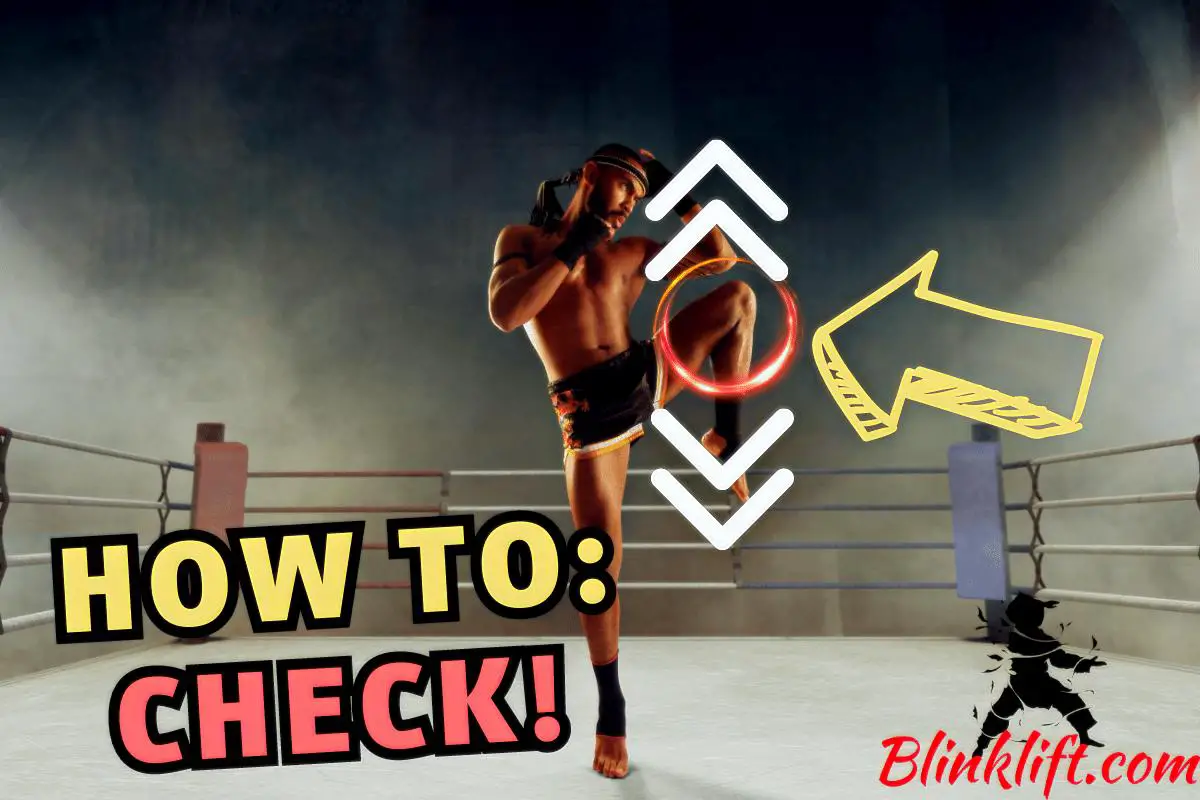The check is one of the most important techniques you’ll learn in Muay Thai. However, many fighters overlook the small details that eventually separate mediocre fighters and exceptional fighters. As a result, I’ve decided to write this article for those of you who want to master the check and become an exceedingly capable fighter.
Checking in Muay Thai is a crucial defensive technique used to block or partially absorb your opponent’s attacks. Proper checking helps protect yourself from strikes and creates counterattacking opportunities. It’s one of the most effective counters to the low kick, which is a common Muay Thai technique.
If you’re interested in learning the small details on your way to perfecting the check, this article will help you do just that. What it’ll also do is allow you to see where most fighters go wrong when executing this block and ensure you don’t make the same mistakes.
Here’s what we’ll cover today:
Table of Contents
Checking in Muay Thai (Tips to Get Better)
Common Check Mistakes (Muay Thai)
Does Checking Hurt in Muay Thai?
How to Check in Muay Thai
The first part of this article is going to cover the basics of checking in Muay Thai. If you want to start executing it, this is the part you want to read. If you don’t know anything about this fantastic defensive move, it’s time you get comfortable with it, as it’ll skyrocket your Muay Thai abilities and transform you into a defense master.
To check in Muay Thai, you want to raise your knee to your chest at a 45-degree angle (facing outward.) Since most kicks will come at you from around, and not in a straight line, you want to check at 45 degrees facing outward. It’s best used against low kicks and body kicks, as it’ll allow you to block them.
There’s so much more to it. Let’s cover some more basics you want to familiarize yourself with. When you raise your knee, do you want the foot to be facing down or up? I’ll be honest with you, it doesn’t matter. As long as you block the kick and recover, you’re doing things correctly. So it really doesn’t matter as much.
Another key point here is what do you do with your guard? The best-case scenario is not to move your guard at all, even if you think crunching will make you less vulnerable. It actually makes you less balanced, which is crucial in Muay Thai. Therefore, stay postured up and ready to recover and counter.

These are the basics of the Check. It’s one of the best defensive moves in Muay Thai, so start practicing it right now. I mean it, stand up and do 10 checks on each side. Don’t skip this step!
Checking in Muay Thai (Tips to Get Better)
Let’s now review tips to get better checks instantly. You want to implement all the tips in this article, as these will make your check exceptional, which is different than, and I’m guessing here, 90% of Muay Thai fighters.
If you’re genuinely serious about your Muay Thai defensive skills, make sure to bookmark this article so to have easy access back to this article. This will refresh your memory and skyrocket your checking abilities.
Without too much introduction, let’s dive into some of the most important tips you want to implement in your Muay Thai checks!
Before we do so, if you want to learn about the most important defensive moves in Muay Thai, such as the check, follow this link.
#1 – Time Your Checks Properly
The first tip is to time your checks properly. I can’t stress this enough, but your opponents will begin playing with you to see how you react to certain attacks. For instance, your opponent might throw a low kick just to see whether you use the check.
If you end up checking, he’ll be more likely to feint the next low kick. Then, you’ll defend yourself with the check and your opponent will go for another strike. This will definitely catch you off-guard.
The point is to time your checks properly. Don’t use them as the only defensive move you know. Instead, learn about proper head movement, footwork, and other defensive techniques. There isn’t an end to effective defensive techniques, so make sure to continue learning more and more.
#2 – Raise Your Knee High
The second tip is to raise your knee high. Strive to get to your chest, which shouldn’t be that difficult. However, check too low and your opponent will hit you with anything that’s not a low kick. For instance, he can throw a diagonal kick (side kick), Roundhouse kick, and even a switch kick and still hit.
#3 – Return to Your Fighting Stance
The 3rd point is about balance. You want to return to your fighting stance after you’re done checking. That will ensure your opponent doesn’t go too aggressive once he off-balances you. In fact, if you keep your balance, there’s a big chance you’ll off-balance your opponent!
This is ideal for following up with a counter of your own; which brings me to the next point.
#4 – Counter After Checking
Once you check, you want to counter. Let’s say you blocked the low kick with the hard part of your shin (which we’ll review later.) Your opponent’s foot is now in real pain, especially if he doesn’t wear shin guards. But even if he does wear a shin guard, he’ll feel your shin and it will hurt.
So make sure to counter to finish the move and inflict even more damage. One of the best counters is a Teep, as you’ll be in a solid position to throw a rear teep.

#5 – Check in an Outward Angle!
The last tip we’ll review is something I’ve already mentioned. However, so many Muay Thai fighters get this wrong and are unable to perform it nearly as effectively. When you check, you want to do so at a 45-degree outward angle.
Most kicks you’ll get hit with will come from the side. As a result, you won’t block them if you don’t check at a 45-degree angle. If you’re checking forward, you’re much more likely to fail and get hit. This is the last thing you want, as this is a defensive move!
Common Check Mistakes (Muay Thai)
What this part will do is cover the most common mistakes you’ll see with the check in Muay Thai. These are mostly made by novice trainees, so you want to avoid them as soon as possible in your journey.
Let’s now review some of the mistakes you want to fix when you’re checking in Muay Thai!
Mistake #1 – Late Checks
One of the most common mistakes is executing the check too late. Timing is crucial in Muay Thai, and if you check too late, you may end up taking the full force of the opponent’s strike. This can lead to injuries, especially when it comes to leg kicks. Work on improving your timing and anticipation, so you can execute the check at the right moment to effectively block or deflect the incoming strike.
Observe the opponent. Observing the opponent will allow you to anticipate incoming kicks, which are hopefully not feints.
Mistake #2 – Overcommitting to Checks
Overcommitting to checks can throw off your balance and leave you vulnerable to counterattacks. For example, if you extend your leg too far when executing a shin block, your opponent might take advantage of the opening and strike you elsewhere. Focus on maintaining a strong guard and a stable base while checking, avoiding unnecessary movements that compromise your position.
I will also encourage you not to lean forward or backward excessively. Instead, stay postured up and as balanced as possible. If you lean forward or back too much when checking, your balance will be off when your opponent returns to his fighting stance.
Mistake #3 – Neglecting Footwork
Footwork is essential for proper checking. Neglecting footwork can lead to being out of position to execute checks effectively. Practice footwork drills to improve your ability to move in and out of range quickly. This will help you get into the proper position to check strikes and maintain your defensive stance during the fight.
If you want to practice your Muay Thai footwork at home with simple drills, follow this link to read about the best drills to do so!
Does Checking Hurt in Muay Thai?
Some fighters might wonder whether checking hurts in Muay Thai. The answer to that is quite simple. Wear your shin guards and it won’t hurt. However, in a real fight, you might wonder whether it’s true. So here’s the best answer to this question:
Checking is a painful experience in Muay Thai both to the fighter checking and the one who kicks. If you’re the fighter who checks, your shin will hit the opponent’s kicking leg, which is going to be painful to your shin. Likewise, his kicking leg will hit the rigid part of your shin, which will hurt his foot a lot.
Make sure to wear your shin guards when you practice your checking ability. Likewise, wear it when sparring, as it can hurt your shin and leg quite badly if something goes wrong with your execution.
Final Words
And this is everything you need to know about the check in Muay Thai. You now are capable of training this at home alone. You want to start by shadowboxing and move on to training with a partner until you feel comfortable using it in spars or competitions.
Remember, although it’s a simple technique, you must dedicate time and effort to learning it as best as possible. So don’t think that you’ll learn it in a few hours or even days. This will take time, so be patient and continue working!
Here are other articles you’d benefit from reading:
How to Catch Kicks in Muay Thai – It’s Actually Simple!
Slip 101 (Muay Thai) – How to Slip and Follow-Up
Is the Bob and Weave Used in Muay Thai and MMA?
Muay Thai Basic Head Movement – Techniques, Drills, and Tips

